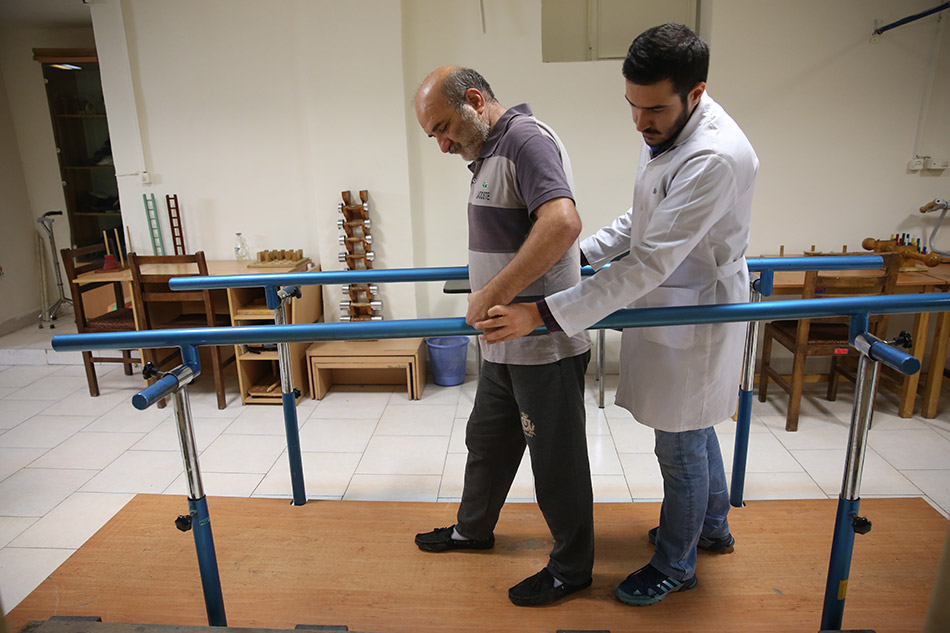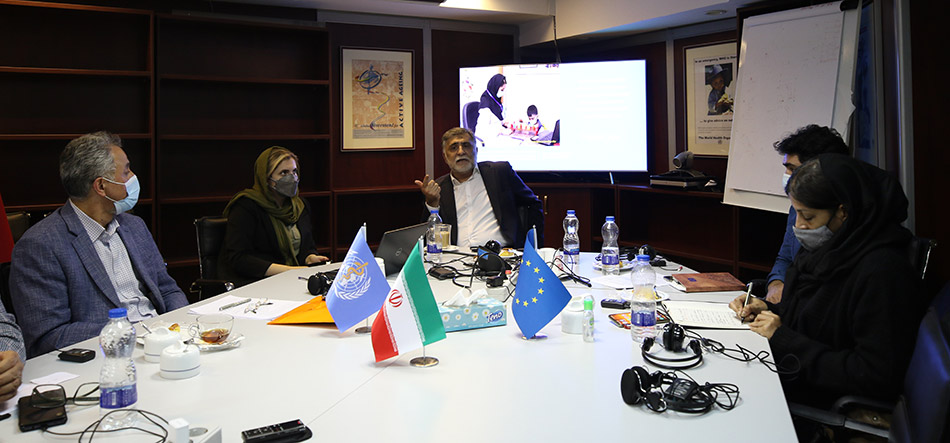 A health care worker helps a man with a disability complete his physiotherapy exercises. Photo: Mr Akbar Badrkhani.
A health care worker helps a man with a disability complete his physiotherapy exercises. Photo: Mr Akbar Badrkhani.
29 November – To support the Iranian national health system in promoting the well-being of the elderly and people living with disabilities, WHO is implementing a project in cooperation with the Ministry of Health and Medical Education and the State Welfare Organization of Iran to improve access to inclusive health care in nursing homes and enhance the quality of life and dignity of these vulnerable populations during the COVID-19 pandemic.
The project, co-funded by European Union humanitarian aid, started in June 2021 and will last 21 months. It is supporting catalytic and innovative activities to increase the COVID-19 response capacity of long-term care facilities, procure assistive technologies (e.g. wheelchairs and walkers) for the most vulnerable, train caregivers in providing tailor-made care and services to the elderly and persons living with disabilities, and establish an online platform and network for research and training.
The project was discussed during a recent meeting in Tehran on 10 November, attended by a visiting team from the European Union humanitarian aid mission in Islamabad, Pakistan, comprising the Head of Office, Taheeni Thammannagoda, and Programme Assistant, Naeem Gul, and the WHO Representative and Head of Mission to the Islamic Republic of Iran, Dr Syed Jaffar Hussain, the project team from WHO’s Healthier Populations Programme and the directors of the family, population and school health and mental health departments at the Ministry of Health and Medical Education and representatives from the rehabilitation office of the State Welfare Organization of Iran.

Representatives in discussion at the meeting. Photo: WHO.
The meeting also discussed the response to ongoing emergencies, including the incoming influx of Afghan refugees, in light of the recent developments in Afghanistan, and reviewed current partnerships and future opportunities for collaboration.
“The goal of this joint meeting is to discuss issues regarding support to the health system in the country, especially in provinces hosting refugee as well as indigenous populations, and highlight the perspectives of the government and European Union experts,” said Dr Hussain, opening the discussion.
“We have witnessed, from our strategic outlook, vulnerabilities in the community, including in mental health, aging, disability rehabilitation and COVID-19 related issues, which require bringing additional and more sophisticated care services to the people of Iran, plus the 3 to 4 million refugees,” said Dr Hussain.
An introduction to the interventions being undertaken by the different partner departments was presented by representatives from the Ministry of Health and Medical Education and the State Welfare Organization of Iran, and the areas where local and refugee populations require psychological and physiological support through the primary health care system were reviewed.
“We would like to invest in bridging the gaps between the identified needs of the national community and existing facilities and infrastructure, as well as the emerging needs due to the new situation in Afghanistan and the refugee crisis, which link to our current project with European Union Humanitarian Aid,” said Dr Rahim Taghizadeh, Head of the Healthier Populations Unit at the WHO country office.
“The current project involves establishing a platform for applying normative standards and the establishment of mechanisms like the training and capacity-building for service providers,” he added, noting that the innovative idea of establishing a network between universities of rehabilitation, welfare, and medicine will increase collaboration between academia and practitioners and help in the development of evidence-based practices.
“WHO recommends further investment in additional interventions for capacity-building courses, improving quality of care and increasing service utilization,” he concluded.
The European Union and its Member States are the world’s leading donor of humanitarian aid. Through its Civil Protection and Humanitarian Aid Operations department (ECHO), the European Union helps millions of victims of conflict and disasters every year. With headquarters in Brussels and a global network of field offices, the EU provides assistance to the most vulnerable people on the basis of humanitarian needs.
* This document covers humanitarian aid activities implemented with the financial assistance of the European Union. The views expressed herein should not be taken, in any way, to reflect the official opinion of the European Union, and the European Commission is not responsible for any use that may be made of the information it contains.




